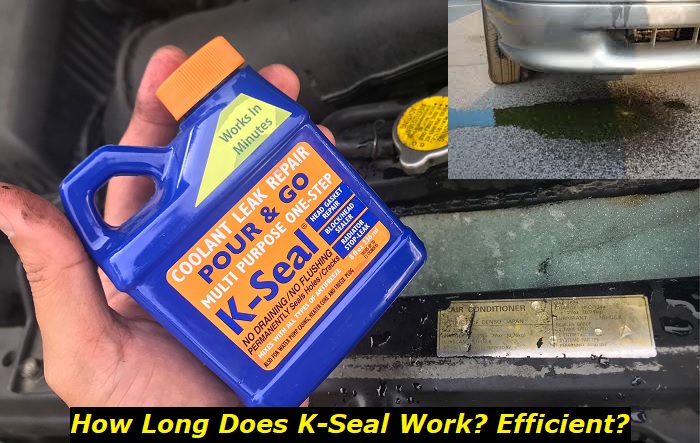The K-Seal coolant system sealant can potentially last forever if it's used properly but, in most cases, it's not used as it should or the mechanisms keep breaking and falling apart, so it may last as long as the crack or leak keeps the same shape and size which is, if translated to understandable time measures, not very long.
Additives for leaks highlights
- Efficiency:close to zero
- Availability:agood deal of brands
- Average price: $35
- Way to use:pour into the coolant tank
- DIY use:yes
- Experts' advice:only biased advice
- Independent testing:onlynegative
- Consequences:contaminated coolant, contaminated cooling system, no effect whatsoever

What's essentially K-Seal?
This is a product that is claimed by its manufacturer to be able to seal almost any leak in the cooling system of your car, truck, bike, ATV, or whatever. The product is easy to use, it doesn't cost you a fortune, and some people say it really works.
But we are not here to give you some advert of K-Seal and not explain to you why and how it works in the cooling system.
I tried to investigate the contents of K-Seal and, expectedly, the manufacturer doesn't reveal the actual formula. But they also state that K-Seal contains copper particles and ceramic microfibers. These elements are said to seal small leaks with the warranty of lifetime effectiveness. This all sounds too cool to be true, so I decided to go further than that.
They say that K-Seal is good for small cracks and holes in the system. Of course, it won't seal a big crack that is even visible to the human eye. K-Seal works with tiny damages in the system and seals them with ceramic and copper particles.
I was wondering how K-Seal understands that a certain leak is a problematic issue and not a technological thing in the cooling system. Modern radiators have so tiny spaces between aluminum plates that a certain amount of coolant leak reducer may actually seal them and kill the radiator.
Unfortunately, I couldn't find any answer on the official pages, so I needed to go and investigate this with mechanics in different repair shops.
When is it OK to use K-Seal?
If you can see the hole or crack that is the reason for the leak, there is no way any sealer will help you with this problem. Replacing your radiator or any other part that is affected by this problem is the only possible choice.
But if the reason for the leak is invisible and only lets you know about its presence by tiny drops of coolant all over the place in your garage, K-Seal may help.
The manufacturer states that the product is good for repairing small leaks in radiators, aluminum pipes, engine head and block, etc. So, basically, it's claimed to seal almost any small leak in the entire cooling system. And even if the leak is internal, for example, located under the head cover, it may work with it and let your engine run for some more time.
Also, the manufacturer specifies that the product is good for holes of up to 0.6 mm in diameter and for cracks that are no wider than 0.25 mm and no longer than 12.7 mm. This proves my guess that any visible big crack in this product will not repair.
How should you use K-Seal to make it last?
When we are talking about the durability of any product, it's important to understand how to use it. In some cases, K-Seal may last zero minutes because you just didn't use it correctly.
At this point, I decided to have a look at the official recommendations of the manufacturer of this product to have an idea of optimal use. And here's what I could find:
- First, you need to shake the bottle a little to activate the formula and prepare the liquid to work properly in the cooling system of your vehicle.
- After that, open the radiator cap or the coolant reservoir cap and pour the entire bottle into it. For smaller systems like in motorcycles or ATVs, you may need only half of the bottle. Important: the engine shouldn't be hot when you are opening those caps!!! You may get injured if you open a coolant cap on a hot engine.
- Start the engine and let it run for a while. You may take it for a short ride to let it warm up to the working temperature.
- Then, you may choose to leave the K-Seal in the cooling system or replace the coolant (which I would certainly recommend).
Also, note that the standard K-Seal bottle is OK for cooling systems with up to 20 liters of coolant in them. For large trucks and special equipment, you may need to use a Heavy-Duty K-Seal bottle to have the needed result.
The manufacturer says that once the repair is done, it's permanent, so you may replace the coolant and the leak will remain repaired. So far, nothing bad about this magical product but please keep reading to learn what I managed to investigate.
How long will K-Seal actually last? (According to real reviews)
When you want to know about the efficiency of a certain product, go to forums. You will see that 90% of reviews about any product like K-Seal are negative. And K-Seal is not an exception. Partially, this happens because the product is not actually magical and can do a limited job when it comes to sealing coolant leaks. But I believe that even with smaller leaks, the efficiency of K-Seal is very questionable.
So, according to my investigation, K-Seal can only seal certain types of leaks. In the majority of cases, it will be helpless, even if the hole or crack is just tiny. If a radiator cracks, it most likely will continue ruining just because it's damaged. And K-Seal or any other sealant will not help here because you can't glue metal with some nano-ceramics and expect it to show all the initial properties.
Even if the initial results after you use K-Seal are OK, in about a week or two, the leak will most likely reappear.
My verdict - K-Seal doesn't last forever and can only for a short time help you with certain types of leaks. Given it doesn't work with big leaks, the product is not worth its money. Although it's my own point of view, I base it on several hundred reviews I read before writing the article.
What do professionals think about K-Seal?
I've spoken to several car mechanics that specialized in cooling system repairs. And they all were laughing really hard when I described all the properties of the product to them. They all proved that my verdict about the K-Seal product was right - it won't last long if it at all lasts.
They also said that now the type of cooling system repairs changed. Earlier they tried to save bad radiators or pipes by soldering them or bringing them back to life in any other way. But now the replacement is the only option.
Modern radiators, engine heads, coolant pipes, and lines are made of different alloys that can't stand any cracks or holes. Once these parts are damaged, they just need replacement. And K-Seal repair looks really like a funny try to save the situation. Just like using a medical patch to repair the scratch on the paint job of your vehicle.
Actually, all professional car mechanics that I've spoken to had the same opinion about any coolant system sealing product including K-Seal. And I couldn't agree more with their point of view.
Verdict - should you at all use K-Seal?
To make a certain conclusion about everything I've said in this article, I should add that I don't recommend K-Seal. For me, it just doesn't make sense. If you have a small leak and some drops of coolant go out of the system every minute, just buy an additional quart of coolant to add if needed to avoid engine overheating.
If the coolant leak is worse than that and the antifreeze goes out with insane amounts, K-Seal will not help you at all.
So, what's the purpose of this product? It doesn't work permanently, it doesn't seal bad leaks, and it just can't understand the difference between the leak and the technical space between two aluminum plates in the radiator.
I also believe that K-Seal may actually damage your vehicle. Especially, if we are talking about one of those modern cars with sophisticated cooling systems. It may clog the coolant lines and eventually lead to even more expensive repairs.
The best solution for a coolant leak is proper inspection and repair. Otherwise, any solution is not long-lasting and not reliable.
About the authors
The CarAraC research team is composed of seasoned auto mechanics and automotive industry professionals, including individuals with advanced degrees and certifications in their field. Our team members boast prestigious credentials, reflecting their extensive knowledge and skills. These qualifications include: IMI: Institute of the Motor Industry, ASE-Certified Master Automobile Technicians; Coventry University, Graduate of MA in Automotive Journalism; Politecnico di Torino, Italy, MS Automotive Engineering; Ss. Cyril and Methodius University in Skopje, Mechanical University in Skopje; TOC Automotive College; DHA Suffa University, Department of Mechanical Engineering






Add comment